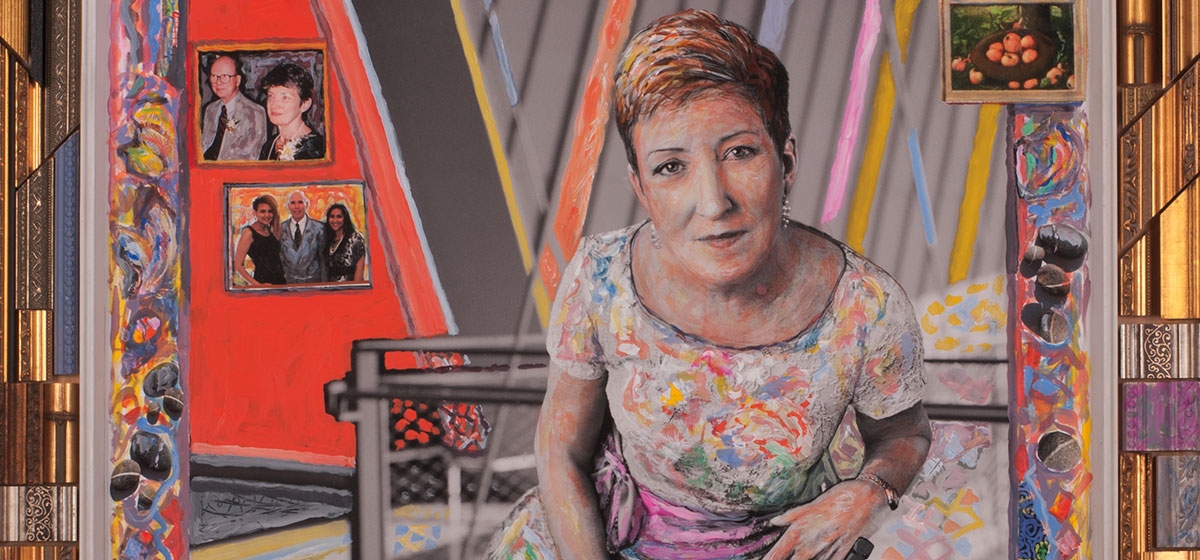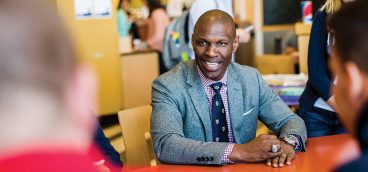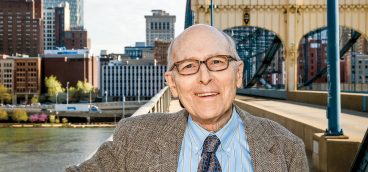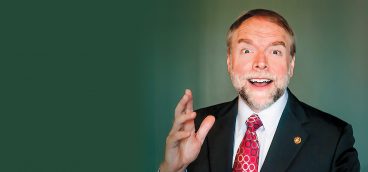Judith Hansen O’Toole, Art Lover

I was born in Minneapolis, one of four sisters. My father was a college professor who was finishing his Ph.D. in American studies at the University of Minnesota, after which he took a job at Penn State. So, I actually grew up in State College, and was a “faculty brat” there. My mother was a stay-at-home mom, so I had a very safe, warm and wonderful childhood.
Our family always took advantage of the opportunities that were afforded us in State College. Penn State brought in a lot of wonderful music and theater, and my parents took us to concerts, plays and musicals as often as possible. And for as long as I can remember, my father, who was an author as well as a professor, would make up stories for us at bedtime. Then, when he was working on a book that took him to art museums, he brought the family along and told us kids the stories behind the artists and their works. When I was in second grade, he taught in Austria for a year, so we relocated, and I have fond memories of museum visits and the stories my father told us there, too.
About the time when I was graduating from State College Area High School, my father moved back to Minnesota to continue teaching, and I decided that it was a good opportunity for me to return to where I was born. I ended up going to school there, at the Minneapolis College of Art and Design, because I had done well with watercolors and oil, and had won some state art awards in high school. So, I thought, “That’s what I’ll do.” But it turned out that I was really terrible at it.
At the end of my freshman year, I sat down with my advisor, who looked at me and said, “So, Judith, what are you going to do with the rest of your life?” And it was pretty clear that she thought it wasn’t going to be visual arts. So, I went to the University of Minnesota and decided to try theater. But that didn’t really work for me either. I was also a classics major for a while because my grandparents had taken me to Greece as a high school graduation present, which was a magical experience. But I ended up in art history and got my bachelor’s degree, and then headed back to State College to graduate school at Penn State, where I continued my art studies.
The further I got into grad school, however, the more tedious it became. Contemporary art really wasn’t embedded in graduate art history programs at that time. My professors were specialists on artists who were, more times than not, dead, and European. As a result, we students ended up divorced from the objects of art and were relegated to studying slides and images, mostly. And sitting in the university library poring over flattened images was not inspiring to me at all.
Luckily, I landed a graduate assistantship with the Palmer Museum of Art at Penn State. It had been newly opened at the time so, if you took any initiative at all, you could do things that you wouldn’t think a graduate student would be privileged to do. I wrote a couple of small catalogs for exhibitions on which our director was working. And I conducted research about the museum’s permanent collection, which had an emphasis on American art. When I began working with American art, especially the more recent pieces, I could actually speak with people who knew the artists, and could sometimes speak with the artists themselves. More important, in the museum workplace, I engaged with objects again, and that was very significant for me. But while I had been going to museums all my life, it never occurred to me that I would have a career in one.
In grad school, I met a sculpture student named Kevin O’Toole who would, in time, become my husband. We were teaching assistants for the same class and shared an office. That’s how we met. When we married, I took his name, although I had a professor who cautioned me about it. My maiden name is Hansen and he thought that “Hansen” would be taken more seriously in the art history world. That just shows you how arrogant the world of art history was (and sometimes still is). But I’ve always used the name “Judith Hansen O’Toole” professionally because I began publishing as “Judith Hansen” before I was married, and because my father had no sons and I felt that I could carry on his/my family name. Also, having come from Minneapolis, which has a strong Scandinavian presence, I was attached to my Danish roots.
I was studying to be an art historian and Kevin was a visual artist, who did his undergraduate work at Cornell. Penn State had a strong art department, which was separated into a school of art history, and one of visual arts. The schools really didn’t communicate with each other because most art historians didn’t like living artists, and living artists didn’t really like art historians because we’d rather wait until they died before we took them seriously. But I had tried to be an artist once and had a love of objects and their makers, so my attraction to Kevin was a natural one (besides other things).
We were an anomaly as a couple because very few students talked let alone dated across “school lines.” Anyway, we both completed our master’s degrees and, once we got married, I began my search for an organization to work for while Kevin continued to work on his sculpture. Fortunately, I got hired as the director of the Sordoni Art Gallery at Wilkes College (now Wilkes University) in Wilkes-Barre. I eventually wound up as an associate professor in its art department, too.
The Sordoni was a great experience for me. While working at the Palmer in graduate school, I had pretty much done every job related to running a small university gallery. I could drive a 26-foot truck into Manhattan or downtown Philadelphia to pick up art. Then, once I got into the gallery, I could help arrange, hang, and light pieces, and so on. I could even write the wall text and labels. What was new at the Sordoni was that I had the opportunity to curate exhibitions, to raise funds and manage budgets, and to engage staff and practice other skills that I would need later in my career. My ability to do almost any job within a museum made me a better leader than those who didn’t have that experience. So, Kevin and I stayed in Wilkes-Barre for 11 wonderful years until we decided to pull up stakes and head to Greensburg to face a new challenge.
When we moved here, Kevin bought a building about a mile from our house where his studio is, and it has worked out well. He was the stable force at the end of the day for our two daughters, aged 2 and 5 when we moved. I would get them off to school in the morning, but Kevin would always be there for them at other times. And he is a better cook than I, so he came to do all the cooking. In second grade, when students were asked to bring in their mom’s favorite recipes, my younger shot her hand up and said, “Mommies don’t cook. Daddies do.” Today, our oldest daughter is in marketing in New York, and our youngest is in retail in Pittsburgh. They are two beautiful, biracial women who each came to us for adoption when they were just 10 days old. And they had a good upbringing here in Greensburg.
Our daughters grew up in the “museum circle.” They did everything from being coat-check girls to helping stuff envelopes for mailings. The middle school is right across the street so, when they spent three years there, they came here at the end of their day and we went home together. I have a picture of our daughters when they were 2 and 5 on the steps of the old museum, and one from last summer with our younger walking under the museum’s new brise soleil on her father’s arm to the gardens where she got married. If you’re lucky, life goes full circle, I suppose. It was kind of amazing to behold, really.
My first years at the Westmoreland Museum of American Art were very challenging. I succeeded the founding director, who had been here for 36 years. People had been trying to encourage him to retire, but it wasn’t working. As is often the case, he was not ready. I came on board and didn’t want a power struggle, but I was across the spectrum from him in terms of what I thought an art museum should be. He had built the collection, and was an old-school, ivory-tower museum director. He didn’t like children coming to the galleries because he considered them a hazard to the art. And his staff felt the same way. But one day, I asked, “Where are the children? After all, they are the future.” And we believe that here now, and do a lot for them. We do storytelling with the pieces in our collection, and refrain from preaching about the artists, where they went to school and how important they are. We tell kids the stories behind the artists and the objects, a method of teaching that was inspired by memories of my father, and that means a lot to me.
Kevin and I moved here with no family and no support. I have an inherited kidney disease that doesn’t usually kick in until you’re older and, soon after we settled in, I learned that I had lost half of my kidney function, and would soon have to be on dialysis. It’s a congenital condition so, obviously, I didn’t pass it along to my adopted daughters, who were very little at the time.
I was just 39 years old and was facing a very difficult future. I was worried about how my board would react to the fact that I had received such a devastating diagnosis, so we kept it secret for a while, which was not easy. Anyway, after my kidneys finally failed in 1999, I was lucky enough to get a transplant, receiving a donated kidney from a gentleman who had died in a car accident. But the new kidney never functioned very well. It had a disease associated with it, and I suffered from many infections and bouts of rejection. So, after 18 months of dialysis, I now had a new kidney, but a bad one. My daughters were scared because there were times in the middle of the night that I’d have to go to the emergency room. Sometimes, we could drop them off with a neighbor, but other times they got dragged along because there was no one to watch them. They rode in the backseat of the car. Or if I went by ambulance, Kevin would follow with the girls in tow. It was traumatic for them, and they still worry about me.
Barbara Jones, our chief curator at The Westmoreland, whom I hired, offered to give me a kidney the first time around, and I said that it wasn’t something we could put on the table. But when my kidneys failed again and I had to return to dialysis for a second time, she walked into my office and said, “I’m not watching you go through that again.” So, she got tested and was a match. I was not going to accept Barbara’s offer, but a very close friend of mine said to me, “You’re being selfish. She wants to do this for you, and she has her reasons. Just be gracious.” It was completely altruistic, so we went to our board and the members were wholly supportive. Barbara gave me a kidney, and gave me my life back. It will be 16 years in September. She’s like the fifth sister in our family now.
When I think about it, my illness taught me a lot. From it, I learned to be resilient and to be a compassionate leader. The experience changed me and the way I managed my life, and the way I managed the museum. And, I think it improved me. Ever since, I have tried to be more insightful into what’s going on in the lives of our staff members, and I’ve mentored them to think that way, too. It’s been a gift, really.
The Westmoreland has been in the same building since it was founded, and it’s a great building. But today, it looks nothing like the original. We own a whole city block, and it’s embedded in the downtown district. When it opened in 1959, it was a pseudo-Georgian-style brick building with four columns and steps going up to it. But because we were just a couple of blocks from the courthouse, it looked like a courthouse annex, with very formal grounds featuring hedges that had to be trimmed constantly. All in all, it wasn’t a very welcoming building, especially for an institution that prided itself on providing public access to fine art.
To his credit, my predecessor added a wing that was mostly to house a gift of two 18th-century paneled rooms that were donated by the Scaife family. He also added gallery and office space. But it still was just a new brick box attached to an old, pre-existing brick box. I felt, from the very beginning, that we had to change the architecture to make the building more enticing and dynamic. And we had to convert the landscape into something that people could enjoy, with pathways, wildflowers and gardens.
Our architects were able to remove the steps from the front of the building and pull down the columns, but the pediment had to remain, being a structural element. Then we built a brise soleil across the front to connect the new cantilevered wing to the older wing, onto which we added a new façade. The piece that we had commissioned for it, by Tim Prentice, is fashioned from metal, and it moves with the wind and changes with the light. It’s a really beautiful piece. As a result of all of this, we became a “destination.”
Today, when you enter The Westmoreland, you’ll see the history of the United States through the eyes of the artists who put it down on canvas or fashioned it in stone, wood or metal. The building that we’ve created is open and inviting, as are the galleries. We have lots of natural light, so you can look outside. We have chairs that you can move around, and on their seats we’ve printed the words, “Take me where you’d like to sit and stare for a while.” We have yoga mats for people to recline on the floor to gain a different perspective on our collection. We don’t try to structure your visit. You can come and have a respite in the middle of your day. Or, you can learn. The most important thing is that the museum is not for our staff; it’s for the community. You don’t need to be educated, wealthy or adhere to a certain dress code to come and be a part of it, because the art belongs to everyone.
We used to be called a “hidden treasure,” which we really didn’t like because we never wanted to be hidden. That made it sound like we were hard to find and a little mysterious. When I first started here, on June 1, 1993, I had a number of goals and, with the help of our staff, our board and our generous funders, those goals have been met. So, on June 1 of this year, I will retire after 25 years. It’s time. The Westmoreland is in the best shape it’s been in since I got here. I feel comfortable turning it over to someone new who has a vision of what the next step might be, and I’m excited about that. It’s funny but, after I announced my upcoming departure, one of my daughters asked, “When you retire, Mom, you won’t be the museum anymore. Who will you be?”
The desk I set up at home in one of our daughters’ empty bedrooms is a long table, actually, which looks out onto two stands of river birches that we planted in front of our house years ago. They have such magnificent, textured bark. But, more interestingly, those trees move with the breeze and their tiny little leaves are always flickering. I’ll be looking out at them as I ease into a new way of being.
It’s an amazing experience for me to close a chapter in my life. To set my own agenda and to proceed at my own pace will provide me freedom in some ways, and feelings of loss in others, I’m sure. But I think the freedom of having the time necessary to figure out what I want to do now is pretty exhilarating. So, who am I if I’m not the museum anymore? I’m Judy Hansen O’Toole: a mom, a wife, and a writer. And I’m moving on.




